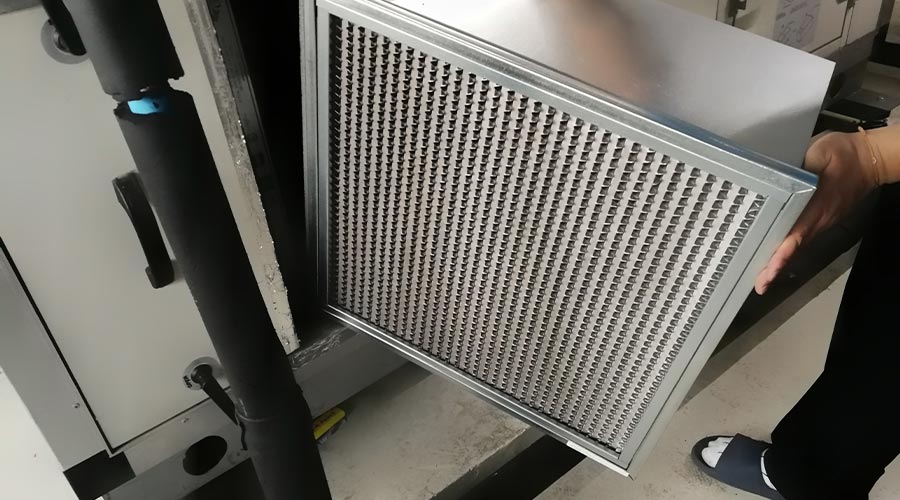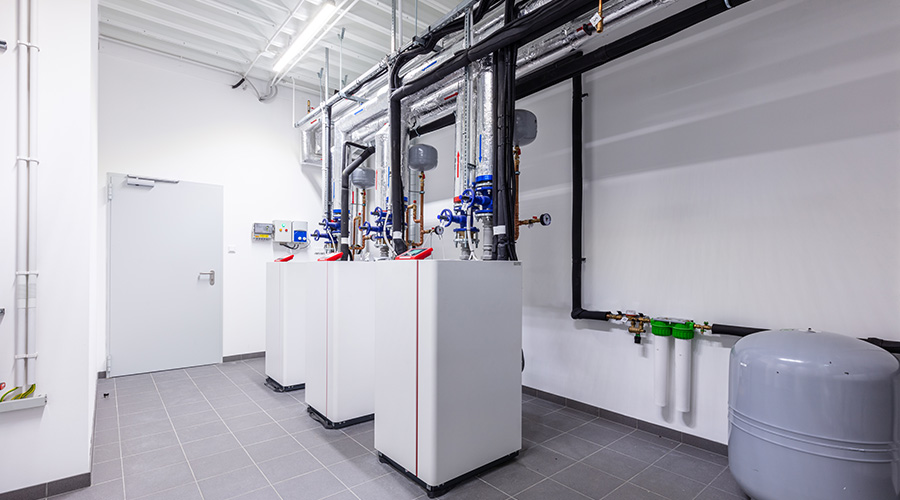Hot Strategies for Cooling Efficiency
Comprehensive maintenance of key equipment ensures that cooling systems keep facilities comfortable and benefit the bottom line
The role of air conditioning in facilities has become so central to effective operations that it can be easy to take relatively smooth system operation for granted. Maintenance and engineering managers, however, don’t have that luxury.
Developing, updating and fine-tuning a preventive maintenance (PM) plan for chillers and related cooling equipment is a central element in providing a comfortable and productive work environment and, just as importantly, holding down an organization’s energy costs.
Component considerations
A typical air conditioning system maintenance program consists of inspecting, analyzing and evaluating plant air handling and energy management systems, a check of ventilation rates, distribution systems and volume controls. Technicians also should visually inspect all equipment and ductwork.
The air conditioning system should be thoroughly cleaned every year, and the condition of coils, dampers and duct linings should be determined. Dirty ducts and filters and unbalanced air flow are common causes for both poor system performance and high energy and operating costs.
If the access path to dampers is near to filters but far from coils, coils can be forgotten and not maintained often enough — unless they are specifically placed on the annual PM program for cleaning and inspection.
These key points in an air conditioning system should be inspected annually after the system is shut down to ensure reliability and lower operating and maintenance costs. The inspection begins with the air intake and continues through the entire system to the exhaust duct discharge to the atmosphere.
Air intake or supply equipment is checked to be sure it is open, that controls work properly and that outside contaminants are not drawn into the building’s air supply. This process includes checking for signs of bird nests or birds roosting in and around ducts.
Inspectors should check mechanical equipment spaces for debris or standing water — a sign of leakage in the building envelope — and for rough operation, imbalance and signs of corrosion and mechanical wear on moving parts.
They also should inspect ductwork for inside dirt buildup, moisture, corrosion and poor connections with the mechanical equipment. Also, they should look for leaks where short circuiting of the air flow can occur, causing uneven cooling.
Supply-air diffusers should be open, should be set properly to balance air flow, should allow air to flow at the proper velocity and air-jet profile, should have no dust or dirt buildup to contaminate or inhibit air flow and should operate at low noise levels.
The same characteristics should apply to the return-air grilles. Technicians should make sure supply diffusers and return grilles are located so they avoid passing air directly from one to another, bypassing the occupants’ space.
Technicians also should check cooling towers carefully and clean them annually. Since these key pieces of equipment are out of sight — usually in equipment spaces or on the roof — they often are easily overlooked until problems already are advanced. Surfaces should be checked for mold and slime, indicating the need to adjust water-treatment chemicals.
Interior plates should be washed down, and the head pan and spray nozzles should be cleaned. Pipelines, pumps, tower pans, strainers and screens can accumulate buildup from the huge volume of water that passes through them. They should be inspected before and during cleaning by someone who can diagnose the conditions observed and assess the treatment that might be needed.
Also, technicians should check the surface condition of components. Severe deterioration and a history of repairs might indicate that it is time to replace — not just clean — some components. This situation is especially true for strainers and screens. If holes are evident, replace these items. If wood is badly rotted, replace it. Managers also should consider specifying longer-lasting, plastic components as replacements.
Inspection into action
When inspections and minor adjustments are complete, supervisors will want to schedule needed maintenance actions on work orders. This approach has several advantages. They can sort out and group the work by trade and area to make it easier to assign the work and reduce workers’ travel time. They also can estimate job times using historical estimates from equipment records or engineered standard times.
The sum of all individual times is the backlog resulting from this year’s inspection. A comparison with the amount of work performed last year will provide managers with an idea of whether the equipment condition is stable or declining. The backlog will indicate the type of trades needed verses what is available.
Window and wall units
Wall and window air conditioning units are mainly air-to-air units — that is, they bring outside air in through an intake, cool and dehumidify it, and exhaust the conditioned air into the room
They contain: a fan; a fan-drive motor — usually a fractional or small-horsepower 120- or 240-volt, 60-cycle AC motor; a compressor that is the permanently sealed type containing a refrigerant; a drain for water discharge to the outside; an air filter; louvers to control the direction of air flow; electrical controls that allow the user either to turn on the variable-speed fan only or to set the cooling temperature at a comfortable level; a casing or housing to contain the system; and a window or wall opening adapter that seals the space between the casing and window or wall frame.
Each of these components requires at least annual inspection, and most of them will need a little cleaning, repair and replacement from time to time. In many instances, these units are still in service and operating efficiently 20 years after they were installed.
The following eight steps will ensure good service life and minimal problems from window and wall units during the cooling season:
- Remove the unit from the wall or window immediately after the cooling season is over and certainly before the first frost to prevent possible trapped water from freezing. If the opening needs a paint touch-up, schedule it now. Then close the window or cover the opening to prevent energy loss and maintain comfortable conditions during cold weather.
- Remove and clean or replace the air filter. If the filter is the permanent type, it can be washed with a detergent and reused.
- Check the drain opening for blockage. Sometimes, mold or minerals build up and block the drain.
- Check and clean the motor fan and compressor by blowing out the dust with an air hose. Check the compressor fittings for leaks using liquid soap or refrigerant leak detector. Add refrigerant, if needed.
- Lubricate the fan and motor. Check full-load amps to ensure the load is within the design range.
- Check and clean the control switch contacts. Remove oxidation, and spray with a sealer.
- Wipe off the casing and louvers, and prime and paint them if chipped. If rust is evident, especially check the bottom of the casing where water can collect between the casing and the window or wall mounting. If any moisture or peeling paint is present here, dry the surfaces thoroughly, scrape and wire-brush loose paint, and prime and paint the metal or wood frame and casing of the unit.
- Reassemble the unit and cover it for winter storage. It will be ready to install in a few minutes next cooling season.
The recipe for success in all such programs is targeting specific facility needs, then tailoring the program to meet these needs and address equipment-specific issue particular to each facility.
A Closer Look: Ice Storage
Comfort-cooling loads tend to peak during certain daily time intervals, normally in summer from 8 a.m. to 6 p.m. Since these peak-demand hours approach capacity limits of the local utility, the utility charges more for power used during this period and less for power used during off-peak hours. Depending on how an organization’s service contract is written, some utilities charge the same higher rate for all power used once demand exceeds a certain threshold.
Ice-storage units generate cooling capacity during off-peak, low-rate hours and store it for use during peak hours. A unit consists of a water reservoir containing submerged evaporator tubes that are coated with ice to a preset thickness during off-peak hours. When cold water is needed for cooling, it is pumped through the evaporator to the cooling load. Warm water from the cooling load is returned to to evaporator, where it cools and melts the ice.
The unit might generate all the cooling load for a facility — often not economical — or a portion of it, lowering the electrical load substantially during peak hours. When off-peak rates begin, the ice-storage refrigeration timer activates and builds up the ice on the evaporator again to the preset thickness.
Since the equipment in the ice-storage system is the same as in other cooling systems, their inspection and maintenance actions are similar. The water-storage tank usually is made of concrete and, other than cleaning and checking for cracks during non-use, requires little or no maintenance.
|
Related Topics:











